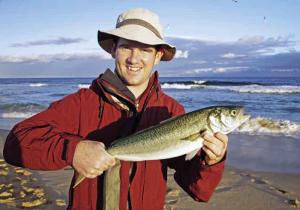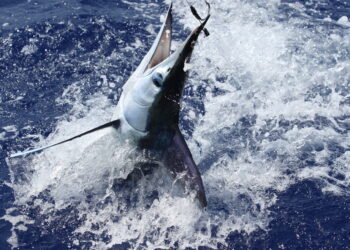The key to successful surf fishing lies with finding a good gutter on a beach which features plenty of waves. No waves, no fish! Gutter Tactics – Part II with pat brennan
LAST issue we talked about finding and identifying gutters. This is crucial in beach fishing because if you’re not in the best place (the gutter) then you’re highly unlikely to find fish. Now it’s time to begin to understand why fish will congregate or pass through a certain area on a beach. The fact is that all fish are influenced by the availability of food, the relative comfort of their immediate environment and the availability of shelter. You should consider these needs in relation to the species you’re trying to catch and then look at a beach and assess where these needs are most likely to be met.
Foraging
Forage fish like bream, whiting or dart generally look around for food items disturbed by the action of the surf. They also need to have somewhere to bolt to should a dolphin, salmon, jewie or shark turn up. On top of this, they don’t want to be in an area where there’s a lot of current or sand suspended in the water. So, what sort of features meet all of these needs?
The calmer and deeper side of the gutter or shorebreak where the force of the current dissipates is a good spot to prospect for forage fish. They pick off crabs, worms or shellfish that are dislodged by the wave action and carried off by the rip. The calmer, deeper water is also away from the discomfort of sand suspended by the turbulence of the waves. When danger is near they can seek shelter in the shallow, foaming water of the shorebreak or sandbank. These fish will often sit in a stationary position and let the current bring the food to them. A good tip is the use of a berley bag full of fish scraps or other stinky stuff tied off to a stake and placed in the wash zone. This will get the scent out to fish in the gutter and bring them to you.
When it comes to rigs, a running sinker rig is a good option for forage fish. I use a fairly light ball sinker to start with in order to allow the current to move my bait around, hopefully to where the fish are. Once I start getting bites, I’ll increase the sinker weight to hold position. My preferred baits include beach worms and pippis.
Hunters
Active, schooling hunters like salmon and tailor cruise up and down a beach looking for the entrances to gutters. When they find one, they head in looking for a meal, because they know baitfish are likely to be holding up there. Most fish are masters at energy conservation and will rarely expend more energy to get something to eat than they are likely to get in return once they’ve eaten it. Therefore, because gutters will usually have a reasonable amount of current or rip, salmon and tailor will often use the current to their advantage and cruise with it, veering off at the sign of prey to make their attack. Similarly, as they enter a gutter they will often surf in on the waves like dolphins. If salmon and tailor find food, they will stay, so if you hook a fish, try and keep it in the water for while as its fighting action will excite others in the school and they will hang around for a while. Also, throwing in a handful or berley can keep fish around. Once they have moved off, don’t be too disappointed because that school or another may very well return.
Rough stuff
Many anglers are put off when conditions get rough and the surf picks up. Provided there’s sufficient depth in the gutter, the fish will still be actively feeding. In fact, they may be feeding more actively as the heavier surf action will dislodge more food for the forage species, which in turn makes the predators more active. The trick is to use a rig that maximises the time your bait stays out in the strike zone. I like a paternoster rig with some form of anchor weight like a star or grapnel sinker. I also almost exclusively use pilchards on a gang hook as bait.
As you may have worked out from the info above, the key to good gutters and reasons for fish being in certain places is dependent on the action of waves. Without the waves, all of the reasons for the fish to be there in the first place disappear. There are no food items being dislodged for the foragers to feed on, no white water for them to hide in and therefore no reason for them to be there. Also, the predators know this and have no reason to hunt the beach. No waves, no fish!
I’m often asked which tide I prefer for beach fishing. If fishing for bream and whiting, I like the last half of the rising tide, preferably, but not essentially, around dawn or dusk. For salmon and tailor, I don’t mind as long as I’m in a good gutter at dawn or dusk. For jewfish, I definitely prefer the rising tide on dusk and will fish through to the next tide change.


















